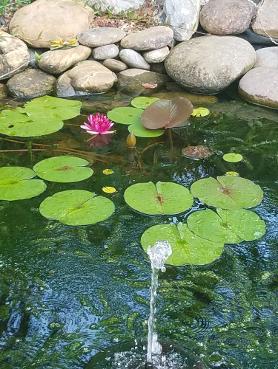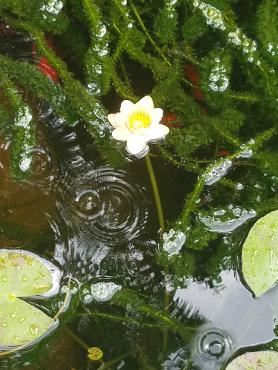It all started with a Pond.




The Pond ~ our first project
Of course it didn't always look like this. . .
When I first moved from NJ to TN, I missed home. I missed my garden and our small pond. I did anticipate this somewhat, to the point that I brought some of it with me. The pond back home was built up over time using rocks that my father had gathered from his travels. That first pond was made with much love by my dad, my son and I. When my dad passed it became a living memorial to him. So of course I could not just abandon it. Some of those larger more meaningful stones my father collected somehow got onto the moving truck.
Our new home had a substantial yard. A blank slate from which to create a beautiful palette of color and diversity. First we worked on the house of course but we soon turned to our outside space. We enlarged the back patio and I moved in a 12 x 32 ft shed to convert to a studio. Right outside the shed is where we started digging the pond.
The ground here is much harder to dig. Luckily the builder who dug the foundation for the slab patio offered us a little help with his digging machine! After the main hole was dug, some hand digging built the waterfall and banks and the interior shelves. We lined it with pond liner and round river rocks of various sizes. I also had a drain installed which would go to the pump in order to help keep the bottom debris free.
It is important to make "the shelves"in the pond so that you will have different levels for plants and water life. The deepest point is roughly 3 feet. You want to make sure this is deeper than your frost line. I feel deeper is better, as over time it may become more shallow due to debris and dry spells and evaporation. We let rain fill our pond, as it has no chlorine in it . But if you are anxious to fill your pond be sure to use a de-chlorinator, like Stress Coat or Hydra Aqua Dechlorinator. Many pond experts recommend adding "good Bacteria to your pond, much like an aquarium. Wait to do this after you have de-chlorinated the water. (At least the next day). We used actual pond water from a source we knew to be a thriving ecosystem. Just a bucketful will work. The chance you take with this method, although it is natural, is that you may be bringing in unwanted bacteria or contaminates. I waited a month before I added fish. In the meantime, I added plants, both floating and potted. I also landscaped the outside and made seating areas to relax and enjoy.
I added 8 Koi, 20 goldfish, and a slew of minnows. The minnows help with the mosquito larvae. After a while we also had a million tadpoles. Various types. Some lizards, a map turtle, a snapping turtle, (not welcome), and an assortment of birds, frogs, and toads. Really wonderful. Since the area does have a lot of wet areas, I have since added bat boxes....but I am still waiting for the bats.
To the right>>> Top: A side pond (for saving fish if for some reason we need to drain the pond for repairs.) Bottom: a bullfrog suns himself.


The build
The healthiest backyard pond will closely resemble a natural pond, with plenty of native plants, some debris settling on the bottom, and perhaps a log or branch floating on the surface. A pond with these ingredients will balance itself, and algal growth will be seasonal and minimal. Our pond seems to take care of itself. Outside of seasonal maintenance and changing the filter material it is a flourishing ecosystem.
- Pumps, waterfalls, and fountains: These elements create a wonderful environment for wildlife. Birds are actually attracted to moving water; provide a place for them to land and birds will be frequent visitors. Keeping water circulating will also help prevent mosquito larvae from hatching.
- Jump-start your pond life: Add a bucket of water from a nearby natural pond. One bucket will introduce millions of organisms to help keep the system in check.
- The depth of your pond and the area you live in: These factors determine the degree at which your pond will freeze. You want to make sure your pond is deeper than the frost line for your area. If your pond freezes entirely to the bottom, plants and wildlife may not survive.
- Safety: If small children play near your pond, you may want to add a fence for safety purposes.
- Water quality: If you fill your pond with water that is being treated with chlorine, use a de-chlorinator.
- Keeping algae in check: Barley straw is a natural way to limit algae growth. It can be bought by the bale for large ponds or in small packs for small ponds.
Hear the lively sound of the frogs in yonder pond!
Copyright All For The Garden 2025
“We are a participant in the Amazon Services LLC Associates Program, an affiliate advertising program designed to provide a means for us to earn fees by linking to Amazon.com and affiliated sites.”